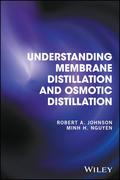Understanding Membrane Distillation and Osmotic Distillation

1. Auflage Juni 2017
288 Seiten, Hardcover
Wiley & Sons Ltd
This book addresses principles and practical applications of membrane distillation and osmotic distillation, separation technologies which are gaining increasing attention due to their advantages over conventional concentration processes.
* Addresses membrane and osmotic distillation, two closely related and novel processes that offer several advantages over conventional concentration processes
* Has a widespread impact and application of the technology in industries such as food, environment, and nuclear clean-up / containment
* Covers theoretical aspects of both processes, the properties of hydrophobic membranes, process economics, integrated processes and future prospects.
* Caters the presentation caters for the diversity of readership with respect to links with membrane technologies.
Acknowledgements
About The Authors
Nomenclature
Chapter 1: General Introduction
1.1 Overview of distillation processes
1.2 Membrane distillation (MD)
1.3 Osmotic Distillation (OD)
1.4 MD and OD as alternatives to established stripping processes
1.5 Established stripping processes
1.6 Other membrane processes
1.7 Concluding remarks
Chapter 2: Theoretical Aspects Of Membrane Distillation
2.1 Introduction
2.2 MD theory
2.3 MD membrane requirements
2.4 Effect of operating conditions on MD performance
2.5 MD process economics
2.6 Concluding remarks
Chapter 3: Theoretical Aspects Of Osmotic Distillation
3.1 Introduction
3.2 OD theory
3.3 OD membrane requirements
3.4 Effect of operating conditions on OD performance
3.5 OD process economics
3.6 Concluding remarks
Chapter 4: Properties Of Macroporous Hydrophobic Membranes
4.1 Introduction
4.2 Theoretical aspects of membrane hydrophobicity
4.3 Membrane types
4.4 Fouling of hydrophobic membranes
4.5 Protection against membrane wet-out
4.6 Hydrophobicity restoration
4.7 Membrane module requirements
4.8 Concluding remarks
Chapter 5: Membrane Distillation Applications
5.1 Introduction
5.2 Desalination
5.3 Industrial wastewater treatment
5.4 Production of liquid food concentrates
5.5 Miscellaneous applications
5.6 Concluding remarks
Chapter 6: Osmotic Distillation Applications
6.1 Introduction
6.2 Fruit and vegetable juice applications
6.3 Other applications
6.4 Concluding remarks
Chapter 7: Future Prospects for Membrane Distillation And Osmotic Distillation
7.1 Introduction
7.2 Membrane module design
7.3 Membrane protection against wet-out
7.4 Utilisation of renewable energy sources
7.5 Membrane-based factory processes of the future: A hypothetical example
7.6 End note
Index
and Chemical Technology at Queensland University of Technology. Prior to entering academia he was a Research Director at Syrinx Research Institute where he oversaw the development of Osmotic Distillation from a laboratory novelty to the pilot plant stage.
MINH H. NGUYEN, BE, GRAD DIP, MSC (UNSW), PHD (UTS) is a Conjoint Associate Professor at the University of Newcastle and an Adjunct Associate Professor at Western Sydney University. He has a lifetime of experience in scientific research and development in industry, research laboratories and university. He was among the pioneers in research and development in membrane technology, in particular membrane distillation and osmotic distillation.


